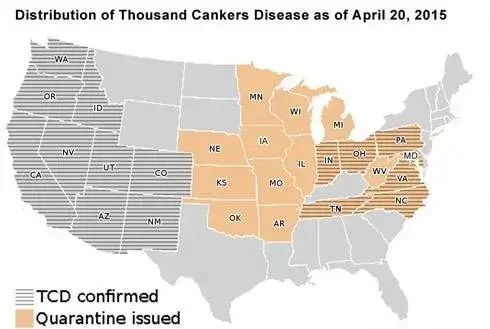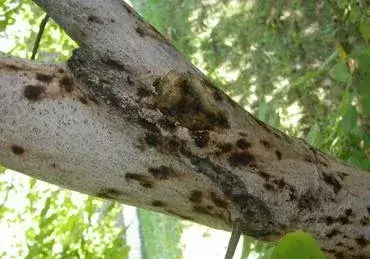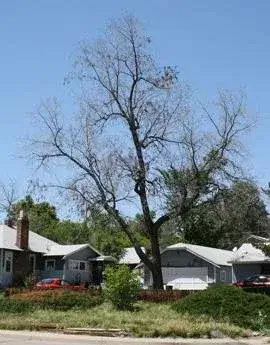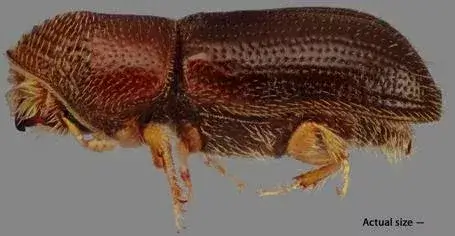
The walnut twig beetle, Pityophthorus juglandis, is a tiny Scolytid bark beetle native to the southwestern US. It is the insect vector of Thousand Cankers Disease. The disease, first observed in the 1990s but not recognized until 2008, has killed many walnut trees planted outside their native range across the western US. It is now a serious threat to walnuts in their native eastern range.

The walnut twig beetle was first detected in the Eastern US in 2010 and has now been found in Tennessee, Virginia, Pennsylvania, North Carolina, Ohio, and Maryland. It is widespread across Western US. While not yet in New York, the walnut twig beetle has been confirmed in adjacent states and poses a threat to walnuts in New York, the Northeast and New England.


The walnut twig beetle is reddish brown to brown and only 1.5-2mm long. Identification of this tiny bark beetle is possible with a dissecting microscope but confirmation by an expert is recommended because there are many similar species. A very good identification guide is “LaBonte and Rabaglia, A Screening Aid for the Identification of the Walnut Twig Beetle, Pityophthorus juglandis Blackman.” The fungus is carried into the tree on the bodies of adult beetles; the beetles bore under the bark, create tunnels or galleries, and lay their eggs.

Thousand Cankers Disease, caused by a fungus and spread by the walnut twig beetle, is usually lethal to walnut trees (Juglans spp), particularly black walnuts (Juglans nigra), within a few years of noticeable symptoms. Black walnut has high economic value for wood production. Throughout its native range, the net volume of black walnut growing stock on timber land was valued at over $500 billion.



Prevention through quarantine is key because symptoms (thinning canopy, leaf yellowing/wilt, tip die-back) appear after it is too late to save infected trees or nearby trees. Most eastern states where the disease has been detected have adopted quarantines on the movement of nursery walnuts and walnut wood. Maps of range and quarantine information can be found here.
Heat treatment of logs before movement for processing has been shown to be an effective way to prevent spread of both the disease and beetle.
Pheromone baited traps have been developed for beetle detection in new areas but are only effective at short range.
Steven J. Seybold, Tom W. Coleman, Paul L. Dallara, Norman L. Dart, Andrew D. Graves, Lee A. Pederson, and Sven-Erik Spichiger. (2012) Recent collecting reveals new state records and geographic extremes in the distribution of the walnut twig beetle, Pityophthorus juglandis Blackman (Coleoptera: Scolytidae), in the United States. The Pan-Pacific Entomologist 88:2, 277-280.
A. E. Mayfield, III ,, S. W. Fraedrich , A. Taylor , P. Merten and S. W. Myers . (2014) Efficacy of Heat Treatment for the Thousand Cankers Disease Vector and Pathogen in Small Black Walnut Logs. Journal of Economic Entomology 107:1, 174-184. Online publication date: 1-Feb-2014.
E. K. Luna , R. A. Sitz , W. S. Cranshaw , and N. A. Tisserat . (2013) The Effect of Temperature on Survival of Pityophthorus juglandis (Coleoptera: Curculionidae). Environmental Entomology 42:5, 1085-1091. Online publication date: 1-Oct-2013.
Randolph, K.C., A.K. Rose, C.M. Oswalt, and M.J. Brown. 2013. Status of black walnut (Juglans nigra L.) in the eastern United States in light of the discovery of thousand cankers disease. Castanea 78(1):2-14.
Tisserat, N., W. Cranshaw, D. Leatherman, C. Utley, and K. Alexander. 2009. Black walnut mortality in Colorado caused by the walnut twig beetle and thousand cankers disease. Plant Health Progress.
Utley, C., T. Nguyen, T. Roubtsova, M. Coggeshall, T.M. Ford, L.J. Grauke, A.D. Graves, C.A. Leslie, J. McKenna, K. Woeste, M.A. Yaghmour, W. Cranshaw, S.J. Seybold, R.M. Bostock, and N. Tisserat. 2013. Susceptibility of walnut and hickory species to Geosmithia morbida. Plant Disease 97(5):601-607
